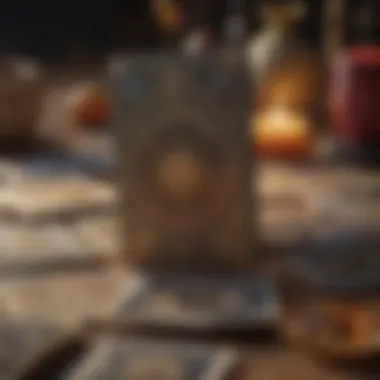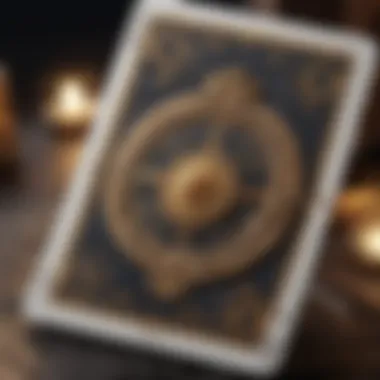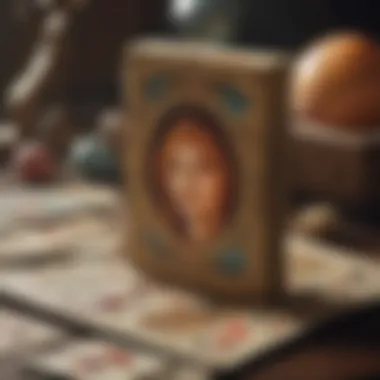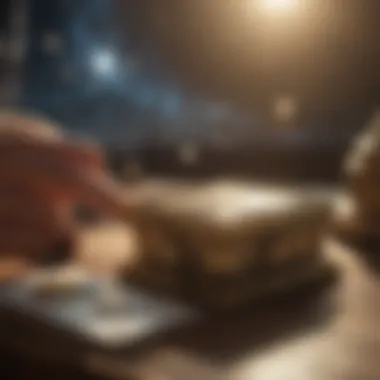The Intriguing Connection Between Cards and Astrology


Intro
The relationship between a deck of cards and astrology reveals a unique intersection, merging two ancient practices that guide individuals on personal journeys. This intersection, while often overlooked, provides deep insights into human nature, destiny, and the influence of celestial bodies. Understanding this synergy could enrich both an astrologer's and a tarologist’s practice.
Through the lenses of history, symbolism, and practical applications, we can unravel how these disciplines work in concert. In this exploration, we will highlight the key points of discussion, emphasizing their relevance to both enthusiasts and professionals in the field.
There is much to learn regarding how card systems align with astrological principles, and equally important is the way these tools offer guidance and clarity. As we embark on this journey, let us delve deeper into the foundational aspects of astrology and its relationship to the symbolism found in deck of cards.
Preface to Deck of Cards in Astrology
The fusion of deck of cards and astrology offers a unique lens through which one can explore personal insights and broader cosmic patterns. This introduction aims to establish a foundational understanding of how playing cards and tarot resonate with astrological principles. It is essential to recognize that both systems hold deep symbolic meanings, each influencing personal growth, decision-making, and intuitive development.
Astrology often utilizes celestial bodies to interpret human behavior and events. In contrast, the deck of cards serves as a tangible medium through which these astrological concepts can be examined. The various forms of card systems bring a visual and interactive element that complements astrology's often abstract nature.
When we look at these intersections, certain benefits arise. For example, those in the fields of astrology and tarot reading find that understanding card symbolism enhances their readings. Integrating numerological insights from both disciplines can lead to richer interpretations. Additionally, a deeper grasp of astrology can inform the ways in which individuals approach their card readings, leading to more effective personal guidance and advice.
Specific elements draw attention in this exploration. In both tarot and playing cards, various suits, numbers, and archetypes correspond to astrological signs. Understanding these connections can add layers of depth to readings, creating a richer tapestry of meaning around one's life and experiences.
By studying the relationship between these two systems, practitioners can consider how they affect personal identity, relationships, and life choices. The goal is to inspire readers to delve deeper into both astrology and card systems and appreciate their potential for personal and spiritual development.
"Astrology and tarot are not merely tools for divination. They are paths to self-discovery and enlightenment."
Historical Context
Understanding the historical context of the intersection between deck of cards and astrology is crucial for grasping their underlying connections. This context provides insight into how these two fields have evolved and influenced one another over centuries. From their origins to modern interpretations, historical developments shape our current understanding of both card systems and astrological practices.
Origins of Playing Cards
The origins of playing cards can be traced back to ancient China, where they are believed to have first emerged in the Tang dynasty during the 9th century. These early cards were quite different from modern decks. The cards spread to various regions, notably through trade routes to the Middle East and Europe.
By the 14th century, playing cards were well established in Europe. They underwent numerous adaptions, leading to the development of the suits we recognize today: hearts, diamonds, clubs, and spades. This adaptation process was not only cultural but also reflected the changing social norms of the times. Each suit began to represent different aspects of life. Understanding these origins is essential, as it creates a foundation for the symbolic meanings that align with astrological interpretations.
Development of Tarot Cards
Tarot cards emerged in the 15th century, initially used for playing games much like modern playing cards. Over time, they evolved into a tool for divination and personal reflection. The tarot deck contains 78 cards, divided into the Major Arcana and Minor Arcana. The Major Arcana generally represents significant life themes and lessons, while the Minor Arcana deals with day-to-day events.
The melding of tarot with astrology started as practitioners sought deeper meanings within the cards. Associating the cards with astrological symbols expanded the interpretative layers available to readers. Understanding tarot's development highlights its connection to astrology and places it in a context for effective usage in readings today.
Cultural Influences on Card Systems
The cultural influences on card systems cannot be understated. Various civilizations have enriched the development of cards and their meanings through their unique perspectives and philosophies. For instance, the incorporation of mysticism from ancient Egyptian beliefs established some foundations for tarot. Similarly, the Renaissance in Europe brought a renewed interest in astrology and metaphysical studies that influenced how tarot was created and utilized.
In Eastern traditions, the I Ching and similar systems provided alternative perspectives that also reflected in cards. Understanding these various influences allows practitioners to appreciate the diversity in interpretations and methodologies. Awareness of these cultural influences is vital for a well-rounded approach in combining astrology and card readings, leading to more insightful practices and deeper understanding.
Symbolism in Deck of Cards
Understanding symbolism in deck of cards is essential for a thorough examination of their connection to astrology. Each element within a card deck carries its significance, and when interpreted correctly, this symbolism enhances the overall insights gained from readings. Symbolism acts as a bridge between the tangible card and the deeper, abstract meanings that resonate on a personal and universal level. This understanding not only benefits practitioners in their readings but also offers clients a more nuanced approach to interpreting their life circumstances.
Suits and Their Astrological Correspondences
The four suits in a tarot or playing card deck play a crucial role in aligning with astrological principles. Each suit corresponds to distinct elements and astrological signs, providing layers of meaning. The suits and their corresponding elements are as follows:


- Hearts (or Cups): Linked to Water, emotions, intuition, and the Cancer, Scorpio, and Pisces signs.
- Diamonds (or Pentacles): Associated with Earth, material aspects, and the signs of Taurus, Virgo, and Capricorn.
- Clubs (or Wands): Connected to Fire, creativity, and inspiration, relating to Aries, Leo, and Sagittarius.
- Spades (or Swords): Tied to Air, intellect, and communication, representing Gemini, Libra, and Aquarius.
Understanding these correspondences not only enriches the reading experience but also aids in identifying areas of focus within one's life. It allows astrologers and readers to interpret how astrological influences manifest in day-to-day experiences.
Numerical Representation and Meanings
Numbers in card systems also contain significant symbolic value. Each number corresponds with specific qualities and energies, which can be aligned with astrological meanings. For example:
- Aces: Represent new beginnings and potential. They can signify an opportunity related to the suit's element.
- Twos: Reflect duality, partnership, and balance, which aligns with Libra's influence.
- Threes: Often denote growth, creativity, and collaboration, resonant with the expansive nature of Jupiter.
- Fours: Symbolize stability and foundation, echoing the grounding traits of Earth signs.
- Fives: Indicate conflict and challenge, corresponding to transformative energies of Scorpio.
Each number expands the reader's ability to discern the depth of a reading, creating pathways for interpretation that are rich in both numerology and astrology.
Major Arcana and Its Astrological Ties
The Major Arcana is traditionally viewed as the more profound aspect of tarot cards, consisting of 22 cards representing significant life lessons and spiritual evolution. Each card in the Major Arcana has direct astrological associations:
- The Fool: Tied to Uranus, symbolizing potential and new journeys.
- The Magician: Associated with Mercury, representing communication and action.
- The High Priestess: Linked to the Moon, embodying intuition and subconscious wisdom.
- The Emperor: Tied to Aries, representing authority and stability.
These connections highlight the role of planetary influence and sign energy within a reading. Therefore, understanding how Major Arcana cards correspond to astrology allows for a sophisticated approach, merging the art of divination with celestial guidance, helping readers navigate their lives more consciously.
The exploration of symbolism within the decks not only aligns with astrological principles but also enriches the reader's understanding of their own life path.
Interconnection of Astrology and Card Reading
The interconnection of astrology and card reading warrants close examination. This relationship provides a unique approach to understanding oneself and the environment. Both disciplines offer diverse tools for interpretation, often enriching one's insight into personal circumstances and general situations. By integrating card readings with astrological principles, practitioners can achieve more nuanced understandings.
Much like astrology, the deck of cards serves as a reflection of the human experience. The symbols present in a deck can reveal hidden insights, echoing the celestial movements dictated by astrology. These connections emphasize the significance of allowing each card to resonate with astrological attributes. The combination can illuminate the forces at play in one’s life and help navigate critical decisions.
Astrological Signs and Their Corresponding Cards
Each astrological sign can be matched with specific cards that embody similar energies. For instance, Aries is often associated with the Ace of Wands, symbolizing new beginnings and ambition. Conversely, Pisces aligns with the Two of Cups, which emphasizes emotions and relationships. These correspondences enrich both the practice of astrology and card reading.
The use of each sign in context enhances the depth of readings. Here are notable sign-card relationships:
- Aries: Ace of Wands
- Taurus: Queen of Pentacles
- Gemini: Three of Swords
- Cancer: The Chariot
- Leo: The Sun
- Virgo: The Hermit
- Libra: Justice
- Scorpio: Death
- Sagittarius: Temperance
- Capricorn: The Devil
- Aquarius: The Star
- Pisces: The Two of Cups
Utilizing astrological signs allows for deeper connections in readings, helping participants to reflect on their unique journey.
Using Cards to Enhance Astrological Readings
Using cards effectively can significantly enhance astrological readings. Incorporating deck draws alongside astrological analysis can reveal additional layers of meaning. For example, the planetary positions can be combined with specific card interpretations to provide clarity and guidance.
Astrologers may employ a variety of card spreads relevant to their inquiry, such as:
- Celtic Cross: Offers a broad analysis of life situations.
- Three-Card Spread: Useful for past, present, future insights.
- Relationship Spread: Assesses connection dynamics between individuals.
When combining cards with astrology, one can align daily astrological influences with drawn cards, providing a practical and insightful perspective.
"The synthesis of these two systems offers a multi-dimensional approach that caters to the profound questions of life."
By exploring the synchronicities between the cosmos and the deck, readers not only build their understanding but may find the guidance needed to navigate challenging circumstances with greater awareness.


Practical Applications of Card-Based Astrology
The practical applications of card-based astrology encompass a wide range of uses that can enhance personal development and understanding of one's life path. By integrating these two systems, practitioners can draw deeper insights and enhance their intuitive skills. Understanding how to effectively utilize cards within an astrological framework offers various benefits, including self-exploration, clarity in decision making, and a unique lens through which to view one’s circumstances.
Using Cards for Personal Growth
Using cards as tools for personal growth is a powerful practice. Tarot cards or playing cards can reveal hidden aspects of one's self and guide individuals toward personal goals. Each card holds meaning that correlates with astrological signs and elements, facilitating a dual approach to reflection. This connection allows users to identify personal challenges and strengths based on astrological insights. To effectively apply cards for personal growth, practitioners may consider setting intentions prior to a reading, thereby focusing the energy on specific areas of their life.
- Personal growth can be enhanced by:
- Understanding the symbolism of the chosen cards.
- Reflecting on one's astrological chart in conjunction to the card meanings.
- Engaging in regular self-reflection practices, which can be woven into daily routines.
Card Spreads and Their Astrological Relevance
Card spreads serve as structured frameworks for readings that can incorporate astrological elements. Each position within a spread can reflect particular aspects of one’s astrological chart. For instance, the Position of the Sun in a spread might indicate core identity, while the Moon's position could reveal emotional states.
When selecting a spread, it is crucial to align it with the astrological query at hand. Specific spreads are especially designed to resonate with particular houses in astrology, allowing for a layered understanding of both cards and astrology. Some common examples include:
- Celtic Cross Spread - Often used for general insights; can relate to overall life themes as indicated in a natal chart.
- Three-Card Spread - Useful for quick insights; can link directly to past, present, and future aspects in relation to astrological influences.
Interpreting Combinations of Cards in Context
Interpreting combinations of cards requires an awareness of both their individual meanings and their interconnected energies. Techniques for interpreting combinations may include considering the astrological signs associated with each card. For example, if a card depicting Aries appears alongside a card representing Libra, the tension between initiation and cooperation is highlighted.
Successful interpretation emerges from:
- Being mindful of how multiple cards interact.
- Weighing the significance of their positions in the spread.
- Recognizing the astrological correspondences that yield further insights.
By combining these interpretations with astrological insights, practitioners can develop a narrative that ties together various elements of their lives. This approach fosters a nuanced understanding and provides guidance that is deeply resonant with the individual.
Engaging with card-based astrology not only blends two profound disciplines but also enriches the interpretations available to both novices and experienced practitioners, paving the way for self-discovery and enlightenment.
Case Studies and Practical Examples
The exploration of case studies and practical examples within the intersection of deck of cards and astrology serves as an essential foundation for understanding how these systems can interact in real-life scenarios. By examining specific instances where tarot readings and playing cards have been effectively utilized alongside astrological principles, readers can gain nuanced insights into their combined effectiveness. These case studies not only demonstrate the practical applications of concepts but also help bridge personal experiences with esoteric knowledge. This can foster deeper comprehension for practitioners and lay enthusiasts alike.
Astrology-informed Tarot Readings
In astrology-informed tarot readings, practitioners use both tarot cards and astrological insights to derive meaning and guidance from their sessions. For instance, one might combine the astrological sign ruling the querent with the tarot cards drawn to create a multifaceted reading. The Major Arcana cards often align with planetary influences, providing additional layers of interpretation.
By focusing on specific astrological placements, such as the Sun, Moon, or Ascendant, the tarot reader can tailor their reading to reflect the querent's personality or life situation. For example, if someone draws The Fool, associated often with new beginnings and ruled traditionally by Uranus, one can consider the querent's Aquarian influences, or lack thereof, to enhance the analysis.
This blending approaches personal growth from various angles. Readers who chart astrological transits alongside tarot can also gain relevance that speaks to the unique timing and energies influencing their clients. Being able to align cards with astrological events can make the reading feel timely and resonant, connecting the person’s immediate experience with universal cycles. This layered insight is why astrology-informed tarot readings are praised within both communities.
Playing Cards in Astrological Forecasts
Playing cards have their own distinct benefits when incorporated into astrological forecasts. Users often employ techniques such as cartomancy, which allows for a different framework than tarot. Each suit in a traditional deck can be associated with specific elements, linking to astrological symbols. For example, Hearts can symbolize water signs, while Diamonds can represent earth signs. Thus, the draw of cards from a standard deck can provide substantial insights into what energies are at play.
In practical applications, a forecast may use the draw of cards to project likely outcomes influenced by current astrological conditions. For instance, if the Queen of Hearts appears in a forecast during a Cancer Moon phase, one might interpret this as indicating emotional clarity or open-heartedness in relationships.
The use of playing cards, much like their tarot counterparts, can also uncover timing. When certain cards reflect the astrological houses, predictions feel far more concrete as one can correlate the houses with the domains of life they govern.


This duality in reading can bring forth significant information tailored specifically to the querent's current astrological climate, raising awareness about future opportunities or challenges they might encounter. By blending the practical use of playing cards with the insights gleaned from astrology, readers find improved methods for affecting decision-making processes and personal growth.
"The union of astrology and card reading reveals patterns, correlations, and opportunities that empower individuals to navigate their paths with clearer foresight."
These case studies importantly underscore how blending decks of cards with astrology enriches the reading experience, providing both depth and practical usefulness to esoteric practices.
The Future of Astrology and Card Interpretation
The intersection of astrology and card interpretation is growing increasingly relevant as both fields evolve. As digital technology progresses, practitioners find new ways to integrate these two disciplines. The ongoing curiosity about personal growth through astrology and intuitive insights from card readings aligns well with societal trends. Thus, it is essential to explore this future to understand how enthusiasts and professionals can adapt to and utilize emerging opportunities.
Advancements in technology allow for innovative approaches in astrological practices. Digital tarot apps and astrology websites provide user-friendly platforms that simplify access to complex symbolic systems. This enhances the learning experience for budding tarot readers and astrologers alike. By leveraging these new tools, practitioners can create more personalized experiences, catering to individual needs and preferences.
Benefits of adapting to these changes included an expanded reach, particularly for those who may not have the means to access traditional practices. Card interaction through online platforms presents countless possibilities for remote and accessible interpretations. Moreover, rising dialogue surrounding mental health and self-discovery has paved the way for card-based skills, illustrative of a deeper understanding of personal narratives.
Emerging Trends in Card and Astrological Integration
Emerging trends signal the growing acceptance of using card systems as supplementary tools within astrological readings. Practitioners increasingly recognize that cards help unveil feelings or obstacles not typically revealed in traditional natal charts. This integration enhances the experience for both the reader and the client, as it provides additional layers of understanding and insight.
One noticeable trend is the combination of traditional astrological systems with more modern cartomancy practices. Readers draw on both the meanings of specific cards and the corresponding astrological signs to deepen interpretations. For example, a reader might consider how the presence of the Ace of Cups, which is often linked to emotional beginnings, interacts with a person's Moon sign. This multidimensional approach presents a more holistic view of an individual’s circumstances and potential pathways.
Additionally, collaborative community spaces are emerging, connecting different practices within astrology and card reading. This fosters a rich exchange of ideas, techniques, and applications. Online communities, such as those found on Reddit or Facebook, create environments conducive to learning and sharing insights, supporting the growth of both disciplines.
Online Platforms and Resources
As the digital landscape continues to grow, numerous online platforms offer resources for blending astrology and card interpretation. There are a variety of websites where readers can refine their skills, connect with others, and learn about different methodologies.
- Educational Platforms: Websites like Coursera and Udemy feature courses specifically on tarot reading and its intersection with astrology. These courses often provide comprehensive knowledge through professional instructors.
- Social Media Communities: Platforms such as Facebook and Reddit host numerous groups focused on tarot astrology. These groups allow members to share experiences, ask questions, and request readings from fellow enthusiasts.
- Apps: Popular applications like Co-Star and Tarot by Labyrinth make engaging with astrology and card readings accessible anytime. These apps offer personalized daily insights, card draws, and astrological forecasts.
- Blogs and Online Guidelines: Websites such as Wikipedia and Britannica have extensive entries on playing cards, tarot, and astrology. They provide foundational knowledge for anyone wishing to deepen their understanding.
Epilogue
In this article, we have explored the intriguing relationship between the deck of cards and astrology. The blending of these two disciplines yields significant insights that can enhance both personal understanding and professional practices for astrologers and tarot enthusiasts. The connection between the two offers valuable tools for interpreting life events, decisions, and personal growth.
Summation of Key Insights
The fusion of astrology and card systems is not merely a curiosity but a robust framework for self-discovery and divination.
- Historial Foundations: The development of playing cards and tarot has deep roots that intertwine with various cultural beliefs and astrological principles. Understanding this lineage provides context for current practices.
- Symbolic Interplay: Each suit and card carries specific meanings that resonate with astrological signs. These symbols can reflect personal traits and influence one’s journey through life.
- Practical Applications: Adopting card readings to enhance astrological insights opens new avenues for consultation. By employing specific spreads and interpretations, practitioners can decode personal challenges and opportunities tailored to clients' astrological profiles.
- Future Directions: As online platforms and communities expand, new methods for integrating astrology and card reading are emerging, indicating a growing interest in this hybrid practice.
"The intersection of these domains is where traditional wisdom meets modern inquiry."
References and Further Reading
Books and Academic Sources
Books and academic sources form a foundation for understanding the principles behind the blend of cards and astrology. They allow readers to explore various perspectives and interpretations in a more structured manner. Here are some recommended titles:
- The Tarot: History, Symbolism, and Divination by Robert M. Place. This book delves into tarot's roots and its ties to astrological elements.
- Astrology and Tarot: The Original Connection by Liz Greene. This tome expands on how tarot cards incorporate astrological meanings, providing insights for both astrologers and tarot readers.
- Playing Card Divination: A Practical Guide by Michael J. Gienger. A practical resource that outlines methods to use playing cards in conjunction with astrological readings.
These books not only explain concepts but offer practical applications. They are beneficial for those who wish to deepen their understanding of how both fields interconnect.
Websites and Online Communities
Websites and online communities play an important role in broadening the discussion about astrology and card systems. They encourage collaboration and sharing of insights among practitioners. Some valuable online resources include:
- Wikipedia offers a general overview of tarot and its historical context.
- Britannica provides detailed articles about the symbolism in cards and their relation to astrology.
- Reddit is a great platform for engaging in discussions on various subs focused on tarot, astrology, and metaphysical topics.
- Facebook groups related to tarot and astrology often share personal experiences and insights about integrating these practices.
These online platforms cultivate a rich environment for learning, sharing, and evolving one's practice. Participating in these communities can enhance knowledge and lead to new interpretations.



